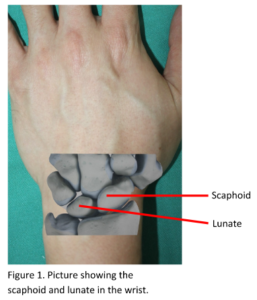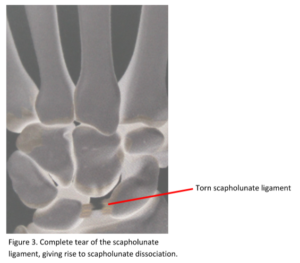Scapholunate Ligament Injury
What is Scapholunate Ligament (SL)?
The scaphoid bone and lunate bone are at the distal end of the radius (thumb side of the wrist). They constitute essential components of the wrist joint’s articulation. These bones are held together by intercarpal ligaments, which are strong ligaments that run between carpal bones. These ligaments are sturdy enough to sustain an axial load through the wrist joint without giving way, yet flexible enough to permit a range of motion between the carpal bones, allowing smooth wrist joint movements.The scapholunate ligament connects the scaphoid and lunate bones and is the most often damaged intercarpal ligament. When this bond between the scaphoid and the lunate bones sustains a complete ligament tear, this is known as scapholunate dissociation.A scapholunate dissociation throws the wrist joint’s balance off, resulting in asynchronous and uncoordinated motion between the carpal bones as the patient moves their wrist. This can result in wrist pain and swelling, clicking, a lack of grip control, and a loss of range of motion. A disorder known as scapholunate advanced collapse (SLAC) may occur in long-term situations. The final stages of SLAC are permanent and end in irreversible osteoarthritis.

How does Scapholunate Ligament Injury occur?

A scapholunate ligament (SL) injury can result from several causes, including sports-related injuries, falls, and car accidents. The most common scenario has a young adult falling on an outstretched arm, forcing the wrist to curve downwards (hyperextend) violently. It is typical of people to dismiss the accident at first, believing it to be a minor “sprain.”The injury becomes permanent if weeks or months pass without a diagnosis. Some people experience decreased range of motion and/or pain in the wrist during strenuous exercises like push-ups and weight lifting, even though they can’t remember a particular injury.
SL Injury Symptoms?
When the scapholunate ligament is injured, the scaphoid bone usually flexes forward while the lunate bone extends downwards. This causes space to appear between the two bones. A partial or complete tear of the scapholunate ligament is a scapholunate ligament injury. A partial tear is a minor sprain, while a complete tear means the ligament has completely broken apart. A scaphoid fracture or lunate dislocation is often linked with a SL injury.
A scapholunate ligament injury can cause the following symptoms:
-
- Wrist pain, especially when trying to put weight on the injured wrist (e.g., trying to do a push-up)
- The wrist makes clicking sounds
- Instability and vulnerability of the wrist
- Weak, painful grip
- Reduction in wrist mobility
- Swollen wrists
Watson Shift Test
The patient should lay his arm on the table, his elbow on it with his forearm lifted. The examiner takes a seat across the table from the patient and places his arm next to his (arm-in-arm, right to right, or left to left). The examiner wraps his other fingers around the distal portion of the radius and sticks his thumb on the palmar side of the scaphoid (on the scaphoid tubercle). The examiner uses his thumb to apply pressure to the scaphoid while he places his other hand on the metacarpal area of the patient’s hand.
The hand is positioned with ulnar deviation and mild dorsal flexion. The doctor moves the hand into radial deviation with slight palmar flexion from this position. Simultaneously, the doctor’s thumb applies constant pressure to the scaphoid tubercle. The distal portion of the scaphoid tilts forward during radial deviation and mild palmar flexion, exerting force against the examiner’s thumb (which is pushing in the opposite direction), creating tension on the joints. A normal wrist can tolerate slight movement caused by this tension.
However, in a patient with ligamentous laxity, this results in a dorsal displacement (‘shift’) of the scaphoid compared to the other carpal bones in the wrist. The change will be diminished, and the scaphoid may collapse back into its usual position when the thumb force is suddenly removed, resulting in a painful ‘thunk.’ It’s crucial to test this technique on both wrists and compare the results.
An audible or palpable reduction of the subluxed scaphoid and elicitation of pain, typically on the dorsal side, indicates a positive test.
What are the SL Injury Treatment Options?
The severity of the tear, the acuity of the fracture, and the prevalence of arthritis all influence treatment of scapholunate ligament injury. Partial tears progress to dynamic instability, static instability, and SLAC wrist arthritis.
Partial SL Tears: A physical examination or x-ray showing no wrist instability in the event of a partial tear. Rest, immobilization in a cast or brace, and pain management are used to treat acute partial SL trauma, followed by recovery and strengthening. If signs of chronic partial tears of the SL ligament remain, an arthroscopy (or “wrist scope”) should be done.
Dynamic Instability: This is diagnosed by stress x-rays when standard wrist x-rays are normal. Widening between the lunate and scaphoid is highlighted using the stress view. This condition results from a complete tear of the SL ligament. Most surgeons recommend surgery to improve the mechanics of the wrist.
Static Instability: This is diagnosed using standard x-rays with a significant gap between the lunate and scaphoid on the frontal view (scapholunate dissociation) and abnormal lunate and scaphoid rotation on the side view (DISI deformity). This condition results from a complete tear of the SL ligament and other stabilizing ligaments of the wrist.
SLAC Wrist: Efficacy of procedures for treating SLAC wrist is minimal after severe wrist arthritis has developed due to a prolonged SL ligament injury. Non-operative therapy aims to keep pain and function as low as possible for as long as possible. Anti-inflammatory drugs, corticosteroid treatments, activity adjustment, and the use of a wrist splint or cast can all be beneficial. If non-operative therapy fails to control pain adequately, the patient may require operative treatment.
When to See a Doctor for SL Injury?
A Hand Surgeon is the specialist to assess and treat the entire spectrum of this condition. Scapholunate restoration is a complicated surgical technique that requires precise treatment of both soft tissue and bony tissues, which a Hand Surgeon best performs.
SL Injury Recovery Time
It is the same for arthroscopic and ligament repair surgeries, about 3 to 6 months. In some instances, non-operative treatment fails because the injury is too severe.
Speak to our hand care team to find out if this is the medical condition you have at +65 6733 9093. Or book an appointment with our hand specialists for a consultation on your symptoms and treatment options.
